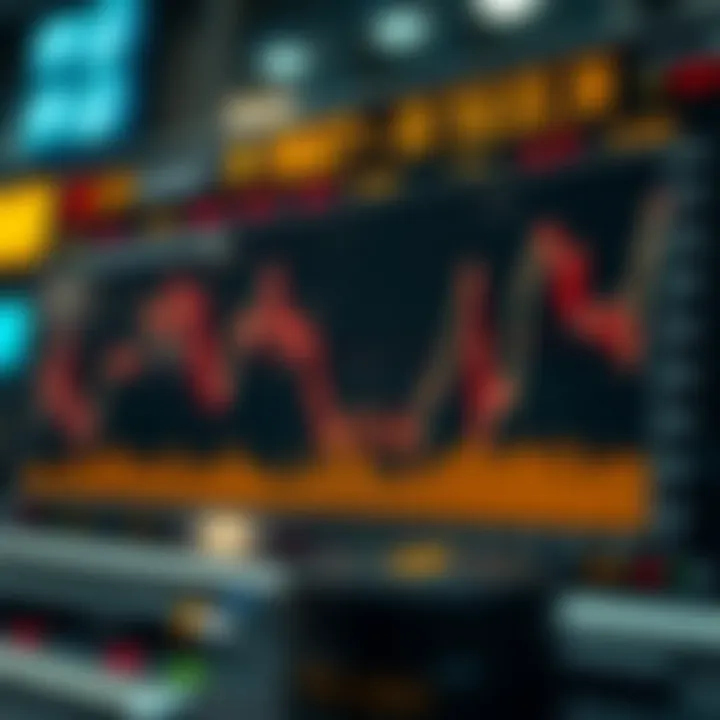The Richest Trader in the World: An In-Depth Exploration


Intro
In the realm of finance, few figures stand out as profoundly as the richest trader in the world. This article aims to peel back the layers on such a trader’s career, methodologies, and the impact they have made on both financial markets and the trading community at large. It is a journey through the intricate landscape of high-stakes trading, grounded in a blend of art and science. The focus will necessarily touch upon their unique strategies and philosophies surrounding risk management, offering insights into what really sets them apart from the rest of the field.
Let us embark on this exploration, taking into account not just the wealth amassed, but also the wisdom acquired throughout their trading endeavors. The aim is to provide a detailed examination that serves as both an informative resource and a critical analysis for those who are keen on understanding the nuances of trading in today's fast-paced financial ecosystem.
Key Concepts in Cryptocurrency
Definition and Importance
Cryptocurrency has shifted from a quirky digital innovation to a mainstay of modern finance. But what exactly is cryptocurrency? Simply put, it's a type of digital or virtual currency that utilizes cryptography for security. Unlike traditional currencies, cryptocurrencies operate on a technology called blockchain, which creates a decentralized network making it harder to manipulate or counterfeit. The importance of this digital currency cannot be overstated. It has paved the way for more secure transactions, offering tremendous potential for traders and investors alike.
Blockchain Technology Overview
To really grasp the significance of cryptocurrency, one must understand blockchain technology. Blockchain can be thought of as a digital ledger that records all transactions across a network of computers. Each block in the chain contains a number of transactions, and every time a new transaction occurs, it is added to the ledger. This ensures transparency and trust – two critical elements in trading and investment.
"Blockchain is not just a technology; it represents a shift in how trust is established across various sectors."
By utilizing blockchain, traders and investors can engage in peer-to-peer transactions without the necessity of intermediaries, thereby reducing costs and increasing the speed with which transactions can be completed. As this domain evolves, the realization of its importance grows clearer among investors, prompting a closer examination of the technological undercurrents that propel market trends.
Trends and Innovations
Emerging Cryptocurrencies
In recent years, we have witnessed the rise of numerous cryptocurrencies beyond the well-known Bitcoin and Ethereum. Tokens like Cardano, Solana, and Polkadot are making waves, each with their own unique features designed to improve transaction speed, scalability, and decentralization. The emergence of these alternatives not only widens the investment landscape but also challenges existing players to innovate in response to this competitive terrain.
Technological Advancements in Crypto
Technological advancements play a pivotal role in shaping the future of trading. With the introduction of aspects like Decentralized Finance (DeFi) and Non-Fungible Tokens (NFTs), the capacity for traders to diversify their portfolios has expanded significantly. The integration of artificial intelligence in trading algorithms is also starting to become more prevalent, making it easier for traders to analyze vast datasets and make informed decisions.
Market psychology has never played a more vital role in trading behaviors, influencing everything from investor sentiment to the infamous FOMO – Fear of Missing Out. The continuous evolution of these trends calls for a deeper understanding of traders' motivations, particularly as technology further intertwines with financial practices.
By diving into the career and strategies of the richest trader in the world, we not only learn about their individual achievements but also gain insight into how these larger trends in cryptocurrency and technology continue to evolve within the financial ecosystem.
As we continue to explore, we will analyze further the intricacies of trading strategies, risk management philosophies, and how one individual has shaped, and continues to shape, the landscape of global finance.
Prelude to Trading Wealth
In the realm of finance, trading wealth is a captivating and often misunderstood concept. It embodies not just the numbers on a balance sheet, but the intricate dance of strategy, timing, and market knowledge. Discussing trading wealth is especially pertinent today, as more individuals venture into the world of financial markets, drawn by the promises and perils of trading.
Understanding the essence of trading wealth isn’t merely about accumulating assets; it's about grasping the methodologies and mindsets of those who have excelled in this fiercely competitive arena. This article aims to illuminate the pathways taken by the richest trader, outlining not just their achievements, but also the lessons gleaned from their journeys. Whether you're an investor sensing opportunity or a trader honing your skills, this exploration promises insights that could redefine your financial approach.
Defining the Richest Trader
Defining the richest trader goes beyond mere monetary figures. It involves characterizing a mindset. Wealth in trading is often measured by profits, but true richness encompasses knowledge, adaptation, and influence. The epitome of this wealth can be seen in individuals who have not only accumulated capital but have also made significant impacts on the markets they trade in.
In practical terms, the richest trader is someone who consistently outperforms their peers. They demonstrate exceptional skill in identifying market trends, making calculated risks, and executing trades efficiently. Their wealth stems from a combination of robust strategies and an intrinsic understanding of market dynamics. In this discussion, we will delve deeper into who this trader is, their philosophies, and the strategies that paved their path to success.
Historical Context of Trading
The history of trading stretches back centuries, rooted in the exchange of goods and services. Initially, traders exchanged commodities like spices or silks, adapting their strategies as markets evolved. The early days of trading were dictated by the physical presence of goods, requiring traders to be agile and insightful.
As time moved forward, especially with the advent of the stock market in the 17th century, trading transformed dramatically. The establishment of stock exchanges signaled a new era where shares and bonds became the currency of trading rather than tangible goods. This evolution brought with it new players: institutional investors, hedge funds, and, eventually, individual retail traders. Each brought unique strategies and philosophies to the table, contributing to a rich tapestry of trading history.
Today, the landscape is continually reshaped by technology and globalization. Access to financial markets has broadened, allowing almost anyone to try their hand at trading. Understanding this backdrop is essential for grasping the complexities of the richest trader's journey. As we explore their life and strategies, we will see how historical shifts have influenced and molded their approach, providing context that enriches our understanding of modern trading strategies.
Profile of the Richest Trader


Understanding the profile of the richest trader is essential for several reasons. First, it helps to shed light on the various elements that contribute to their success, allowing aspiring traders to glean insights that may inform their own trading journeys. This section will delve into the background, accomplishments, and trading philosophy of this remarkable individual, painting a picture of what it takes to reach the pinnacle of trading.
Background and Early Career
The roots of any successful trader often lie in their early experiences. The richest trader in the world, for example, began their journey far from the bustling markets of today. Born into a modest family, they displayed a keen interest in finance from a young age. This keen interest was nurtured through rigorous education, where they studied economics and finance, gaining a solid foundation in market principles.
In their early career, this trader faced significant challenges, often starting from ground zero. They took on junior analyst positions at small firms, putting in long hours to analyze market trends and learn the ropes. The grind was real; many would have given up, but not this trader. They keenly observed the market intricacies and started to develop their own approach to trading, which would later become the bedrock of their success. It's a reminder that sometimes, the journey is just as important as the destination.
Major Accomplishments
Accomplishments in trading can be quantified in various ways—massive returns, groundbreaking strategies, or perhaps even industry recognition. For the richest trader, all these factors play a role. They have not only amassed a staggering fortune but also redefined trading strategies for a generation.
Some highlights of their career include:
- Inception of a Hedge Fund: This trader founded a fund that achieved remarkable returns, pulling in high-profile investors and gaining recognition in the industry.
- Innovative Strategies: Many of their trading strategies have become benchmarks, illustrating how they harness technical and fundamental analysis unlike peers.
- Global Influence: Their work and insights have reshaped how traders and institutions approach investment, making them a sought-after speaker at financial forums worldwide.
Their contributions have created ripple effects in the trading community, often guiding new strategies or even spurring new regulations.
Personal Trading Philosophy
What sets the richest trader apart isn’t just the wealth amassed, but the philosophy that underpins their trading decisions. This trader approaches the market with a careful blend of analytical prowess and emotional intelligence. They understand that trading isn’t merely about numbers; it’s a psychological game where human emotions often drive market movements.
One prominent aspect of their philosophy is risk management. Instead of charging headfirst into opportunities, they advocate for a measured approach. Rules are established, such as not risking more than a predetermined percentage on any single trade. This methodical stance resonates with many, as frequent market turbulence underscores the necessity of caution.
They also emphasize the importance of continuous learning. No one, including themselves, knows it all. They are always looking out for new strategies, embracing technology, and learning from market shifts.
“In trading, you must adapt or become obsolete.”
The Strategies of Success
Understanding the strategies that propelled the richest trader in the world to success provides invaluable insights for anyone looking to navigate the often tumultuous waters of financial markets. These strategies are not just a collection of tips but rather an intricate tapestry of methods and philosophies, each contributing to an overall approach that emphasizes growth, sustainability, and adaptability. By delving into these key strategies, investors, marketers, and analysts can gain a clearer perspective on how to potentially replicate such success in their own trading endeavors.
Risk Management Techniques
One cannot stress enough the importance of sound risk management in trading. The richest trader approaches risk not as a daunting specter but as a natural part of the financial landscape that can be navigated with skill and foresight.
- Diversification: This isn't merely splitting investments across various asset classes; rather, it's about understanding the interplay between those assets. For example, investing in Apple, Walmart, and Goldman Sachs can provide a safety net, yet the richest trader often looks deeper, assessing industry correlations to optimize returns.
- Position Sizing: Knowing how much capital to allocate to each trade is crucial. The richest trader employs a method where the risk on a potential trade does not exceed a certain percentage of their total capital. This principle allows them to weather the storm during unfavorable market conditions without depleting their resources.
- Stop-loss Orders: Setting these orders effectively can be the difference between a manageable loss and a catastrophic one. The richest trader doesn’t hesitate to use stop-losses not only to protect profits but to minimize potential downsides effectively.
Incorporating these techniques separates gamble from strategy, enabling traders to focus on long-term growth rather than short-term gains.
Technical Analysis Aspects
In this high-stakes world, technical analysis serves not merely as a tool but as a language. The richest trader is fluent in this language, interpreting charts like a seasoned author reads novels.
- Chart Patterns: Recognizing patterns such as head and shoulders or triple bottoms is critical. These patterns often indicate market sentiment, helping to make educated predictions on future movements. The richest trader often highlights patterns that display bullish or bearish trends, subsequently adjusting their strategies accordingly.
- Indicators and Oscillators: Tools like the Relative Strength Index (RSI) or Moving Average Convergence Divergence (MACD) are staples in their approach. By discerning when an asset is overbought or oversold, they can make timing decisions regarding entry and exit points that elevate the probability of success.
- Volume Analysis: The richest trader understands that price movements accompanied by significant volume usually indicate stronger trends. Thus, they meticulously analyze trading volume to gauge market momentum.
By integrating these technical analysis tools, the richest trader adds layers to their decision-making process, enabling a nuanced and informed approach to trading decisions.
Market Psychology Insights
Market dynamics are influenced as much by individual and collective psychology as they are by economic indicators. The richest trader possesses an intrinsic understanding of this fact.
- Sentiment Analysis: They regularly gauge market sentiment using various sources, from financial news to active forums. Understanding how news affects traders on platforms like Reddit or Twitter allows for intelligent positioning ahead of market reactions.
- Fear vs. Greed: The richest trader remains calm amidst the chaos stirred by fear or greed. They know to capitalize when others flee, often acquiring positions on dips when fear overwhelms the market.
- Behavioral Biases: An awareness of typical cognitive biases—like overconfidence or loss aversion—shapes their strategies. They adapt their trading to reflect the behavior of others, utilizing this knowledge to maneuver through the market's psychological landscape.
"Trading is not only about numbers, patterns, and strategies; it's about understanding the mood swings of the market and positioning yourself to embrace the advantages while others are caught off guard."
The richest trader’s ability to intertwine technical proficiency with psychological acuity contributes significantly to their sustained prominence in the trading world. Through effective risk management, astute technical analysis, and a profound grasp of market psychology, they craft strategies that extend beyond mere results into the realm of mastery.
Technological Influence on Trading


In the rapidly evolving landscape of finance, technology plays a pivotal role. The impact of technological influence on trading is profound, reshaping how traders operate and strategize. Understanding this influence is crucial, especially when considering the world’s richest trader. Their success isn’t solely attributed to traditional acumen but rather the integration of sophisticated technologies that streamline trading processes and enhance decision-making.
Algorithmic Trading Emergence
Algorithmic trading is the backbone of modern trading strategies. At its core, this method uses computer algorithms to execute trades at speeds and volumes that are impossible for human traders. The rise of algorithmic trading began in the 1970s but gained significant traction in the 2000s. As technology progressed, trading firms adopted these methods to minimize human error while maximizing efficiency.
The benefits of algorithmic trading are noteworthy:
- Speed: Algorithms can process vast amounts of data nearly instantaneously, allowing for high-frequency trading that capitalizes on small price movements.
- Consistency: Utilizing pre-set rules means trades can be executed in a consistent manner, unaffected by emotional turbulence.
- Backtesting: Traders can test strategies against historical data to evaluate their potential before live trading.
Nonetheless, challenges persist, such as market manipulation concerns and the need for robust risk management frameworks to prevent massive losses during unforeseen market conditions.
Utilization of Data Analytics
Data analytics have become the lifeblood of trading decision-making. Top traders rely on complex data sets to inform their strategies. Not only do they analyze market data but they also delve deep into macroeconomic indicators and global events, crafting insights that purely rely on instinct wouldn't yield.
The advent of big data has transformed analytics into a powerful weapon. Here are some uses of data analytics in trading:
- Predictive Analysis: This involves forecasting price movements based on historical data patterns. It’s akin to having a crystal ball that reveals potential future market behaviors.
- Sentiment Analysis: Through social media and news sentiment data, traders can gauge market emotions. Tools that scrape and analyze social media posts can reveal bullish or bearish sentiments prevalent among market participants.
- Risk Assessment: Traders utilize analytics to evaluate trading risks meticulously. Predictive models can uncover potential risk factors, allowing traders to adjust their strategies accordingly.
While the realm of data is vast, the challenge is distinguishing between noise and actionable insights. The trader who can sift through data efficiently stands to gain the most.
Impact of Social Media and Information Sources
The rise of social media platforms has revolutionized how information is disseminated and consumed in trading circles. Traders no longer rely solely on traditional news outlets. Instead, a tweet or a post can swing stock prices dramatically.
Consider these points on how social media impacts trading:
- Real-time Information: News spreads faster than wildfire across platforms like Reddit and Twitter. Traders must keep their ears to the ground, as a single post can trigger waves of buying or selling.
- Influencer Insights: Influential figures in finance can shape market sentiment with their words. The opinions of a respected trader can sway the decisions of thousands, creating a ripple effect in the markets.
- Community Engagement: Forums and groups allow traders to share insights, strategies, and experiences. Engaging with a community can lead to smarter trading decisions and shared learning.
However, social media is not without its pitfalls. Misinformation can lead to panic or unwarranted optimism, and traders must approach this new era of information with a critical eye.
"In the realm of trading, those who leverage technology wisely reap rewards, while those who ignore its importance may find themselves on the losing end."
While technology continues to drive the evolution of trading, understanding its intricacies is crucial for anyone aiming for success in the financial markets. With every advancement, traders must be agile, adapting and rethinking their strategies to stay ahead in the game.
Global Market Impacts
Understanding global market impacts is critical when analyzing the intricacies of trading, especially through the lens of the world's richest trader. This trader’s strategies don't just affect their own portfolio; rather, their actions ripple across the financial landscape, influencing a multitude of sectors and stakeholders. In trading, the effects of decisions often extend well beyond individual trades, presenting both opportunities and challenges that can sway entire markets.
One of the primary elements to consider is how significant capital flows can warp market equilibrium. When the richest trader maneuvers large amounts of money into a certain asset class, it can lead to price movements that are disproportionate to the underlying value of that asset. This may draw the attention of other investors, further magnifying the effect as they scramble to partake in the momentum, leading to a feedback loop. Understanding this dynamic is crucial for anyone looking to grasp the broader implications of high-net-worth trading strategies.
In addition, a keen awareness of geopolitical factors can greatly benefit traders. Economic sanctions, trade deals, or conflicts can have drastic impacts on market stability. Thus, the insights from the richest trader often capture data from disparate sources, synthesizing information across fields to forecast possible outcomes. Their ability to adapt to changing situations reflects a sophisticated understanding of the complexities involved in global finance. This responsiveness is one reason their strategies tend to be imitated but rarely matched.
Moreover, the volume of information consumed and analyzed by this trader is substantial. Leveraging vast repositories of data, their foundational belief is that knowledge is power. If we look at trends, emerging markets, or even regional crises, their shifts can have far-reaching effects on financial systems worldwide. The richest trader inevitably becomes a focal point for understanding these dynamics, serving both as a beacon and as a harbinger within the trading community.
Influences on Financial Markets
The influence of the richest trader on financial markets cannot be overstated. Their decisions can cause reactions that span sectors and even entire economies. A single investment in a tech startup can not only uplift that company’s stock but can also spill over into increased investor confidence, subsequently driving up related sectors like real estate or consumer appliances. The interconnectedness of these markets means that trading is not merely a zero-sum game; instead, it morphs into a symbiotic relationship.
Additionally, the media plays a crucial role in amplifying their impact. When the richest trader makes headlines through a massive acquisition or public statement, it creates a narrative that can shift market sentiment almost instantaneously. News outlets buzzing with the latest moves can lead to both enthusiasm and pessimism, affecting buying patterns across the board.
Navigating Economic Downturns
Economic downturns highlight the efficacy of a trader's approach to risk management and decision-making processes. During such turbulent times, the richest trader often re-evaluates their strategies, seeking shelter in more stable assets or even short-selling overvalued stocks. Their foresight allows them to pivot quickly – a lesson other traders must heed when navigating these financially treacherous waters.
Adopting flexible trading strategies becomes essential during downturns. This trader frequently recommends diversifying portfolios as a protective measure, emphasizing that the best hedge against market volatility is a broad array of investments. They often highlight that staying informed can make all the difference; understanding macroeconomic signals can help in anticipating shifts before they impact investments.


Lessons from Market Volatility
Lessons from market volatility are as varied as the traders who experience them. Often, the richest trader reminds others that volatility should not be feared but rather embraced as a component of market dynamics. Daily price swings can reveal opportunities for those equipped with the right knowledge and tools.
Through their lens, market fluctuations serve as a reminder to be subjective about one's own misconceptions related to investing. For example, many novices may panic during dips, while seasoned traders see these moments as opportunities to acquire undervalued assets.
To distill these experiences into actionable insights, experts suggest:
- Stay rational: To avoid emotional decision-making, remain committed to a well-researched plan.
- Keep learning: Each market trend teaches something useful. Broaden your understanding continuously.
- Adapt quickly: Develop strategies that allow for fast pivots without being rash.
"In trading, only the patient endure; volatility is both teacher and enemy. Learn its lessons wisely."
These insights emphasize adaptability and preparedness, framing the richest trader not merely as a figure of wealth, but as a well of knowledge capable of guiding others through the ebbs and flows of the financial tide.
Future of Trading
The future of trading is not just a far-off notion; it’s unfolding right before our eyes. With technology shaping every facet of our lives, trading is no exception. This section aims to dive deep into effective insights that pertain to emerging trends in this dynamic landscape. Preparing for this future is crucial not just for seasoned traders but also for newbies who are stepping into the arena, as increasingly sophisticated tools and strategies emerge. Understanding these developments can offer significant benefits, from enhanced decision-making processes to boosting the likelihood of success.
Emerging Trends in Trading
An array of exciting trends are reshaping what trading looks like today. Among these, algorithmic trading is one that’s garnered attention. This practice leverages computer algorithms to automate trading strategies. As data becomes more abundant, traders are embracing rapid execution, which often translates to improved profitability. More often than not, these systems analyze vast numbers of factors that a human could never keep track of, let alone process in real-time.
Alongside this is the rise of artificial intelligence in trading patterns. AI analyzes historical data and learns from it, providing traders with predictive insights. This technology is no longer just a far-off dream; it’s being implemented in real time to evaluate trades with almost robotic precision. The real beauty lies in the adaptability. Algorithms can adjust strategies based on live data, making them more agile than traditional methods.
You also can’t overlook the influence of social trading platforms, which allow individuals to copy trades from successful investors. This democratizes access to advanced trading strategies, helping those who may not have the experience yet to benefit from seasoned traders’ insights. It’s a kind of collaboration that has not just evolved but has firmly taken root, reshaping the fabric of trading communities.
Predictions for Market Evolution
No one has crystal balls, but predictions can serve as guiding stars for what's coming next in trading. Analysts foresee a surge in decentralized finance (DeFi), which uses blockchain technology to eliminate intermediaries in financial transactions. With this shift, the landscape will likely become very different, offering more opportunities for traders who adapt early.
Less is often said about sustainable investing, yet it’s gaining traction too. Traders are increasingly looking at environmental, social, and governance (ESG) factors as criteria for making trades. This focus is partly driven by consumer demand for responsible investing, making it something that traders will need to consider seriously.
"The modern trader is not just a number cruncher; they’re becoming part of a larger ecosystem that values ethical standards and relational dynamics in finance."
Finally, hybrid platforms are beginning to blur the lines between traditional trading and newer methodologies. The expectation is that the future will see more integrations where AI, human intuition, and algorithmic trading coexist seamlessly. Keeping an eye on these avenues can offer traders foresight into beneficial adjustments.
Rethinking Trading Strategies
In a world that pivots like a see-saw, trading strategies must evolve—there’s no room for complacency. Flexibility is paramount. The growing emphasis on data analytics allows for a real-time evaluation of strategies. Traders must ask themselves: Are their methods outdated?
For instance, strategies that worked during market bull runs might not hold water during downturns. Those who can pivot and adjust—not merely react—will be the ones who thrive. Trying predictive analytics could be a game changer. By relying on machine learning, traders can spot potential market shifts before they happen, allowing them to position themselves advantageously.
Moreover, emphasizing long-term sustainability over short-term gains may attract a more loyal investor base. Consumers increasingly want to align their investments with their values, which means that carving out a unique niche can have long-term payoffs.
In summary, the future of trading is not merely a continuation of present trends but a whole new ball game. Old paradigms will bend, and new opportunities will emerge. For anyone serious about trading, understanding these nuances will be vital for navigating the intricate web of tomorrow's financial landscape.
Finale
In wrapping up our deep dive into the life and strategies of the richest trader in the world, it’s essential to reflect on the key takeaways that stretch beyond mere numbers and achievements. Trading isn’t just a profession; it’s a journey, rife with lessons that can illuminate paths for both aspiring traders and seasoned investors. This exploration underscores the multifaceted nature of trading, illustrating how wealth is not merely a measure of financial success, but also a reflection of knowledge, strategy, and adaptability.
Reflection on the Journey of Trading
The journey of trading, especially for someone reaching the pinnacle of financial success, showcases resilience and a deep understanding of market dynamics. Each misstep and triumph contributes significantly to the wealth of experience. According to reports, many successful traders credit their growth to learning from losses just as much as wins. For instance, in the aftermath of his first significant loss, he didn't just lick his wounds pining over his bad luck; instead, he revisited his strategy, seeking insight from mentors and peers, and evolving his approach. This adaptive learning is a crucial element that sets elite traders apart from the crowd.
- Continuous Learning: The financial landscape is perpetually shifting, influenced by global events, technological advancements, and changing consumer behavior. Successful traders continuously seek to enrich their knowledge base through reading, courses, and by engaging in trading forums like reddit.com.
- Emotional Resilience: Beyond technical skills, the ability to manage emotions is vital. Trading involves high stakes, and pressure can be overwhelming, leading to impulsive decisions. The richest traders educate themselves not only on market trends but also on psychological strategies to remain calm and focused. This combines patience with decisiveness, a precarious balance crucial for success.
In summary, the rich trader's journey speaks volumes about the importance of fostering a mindset geared towards learning, adaptation, and emotional control.
Final Thoughts on Wealth and Influence
Wealth and influence turn into a double-edged sword in the world of trading. While there’s undeniable power in capital, the richest trader demonstrates that true influence comes from understanding the market's intricacies and shaping conversations around trading strategies. The keys to this empowerment rest not only in financial clout but also in ethical considerations and responsibility.
- Market Impact: The actions of wealthy traders can ripple through financial markets, positively or negatively influencing stock prices, investor behavior, and broader economic conditions. It’s vital to recognize this power; a single trade can set off a cascade, affecting countless lives and businesses.
- Corporate Responsibility: With wealth comes responsibility. Many prominent traders increasingly leverage their influence for social good, investing in ventures that promote sustainability or support underprivileged communities. This demonstrates a profound understanding that trading cannot exist in a vacuum; our actions have far-reaching consequences.
To conclude, the riches amassed by elite traders symbolize not just individual success but also a continuously evolving interaction with global markets. As they navigate through their journeys, those looking to make their mark on trading can glean invaluable insights from their philosophies surrounding wealth and influence. The darkness of market volatility illuminates the importance of ethics, strategy, and responsibility, encouraging future generations to engage with a sense of duty alongside ambition.















